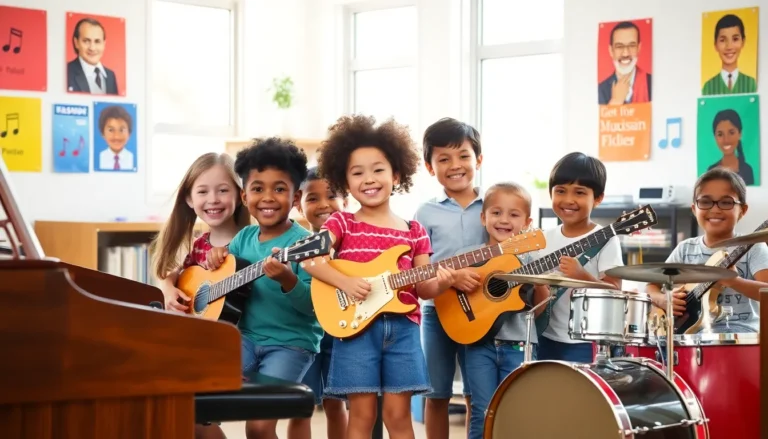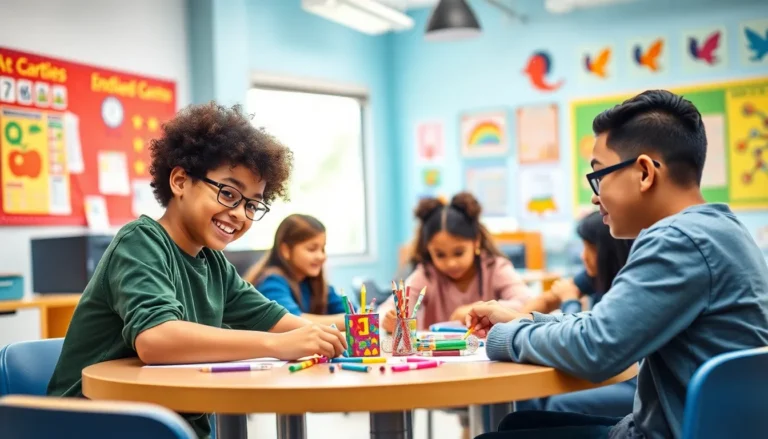In a world where information flows faster than a cat video going viral, finding the right educational resources can feel like searching for a needle in a haystack. But fear not! Whether you’re a student battling the homework monster or a lifelong learner seeking to expand your knowledge, the right tools are out there, just waiting to be discovered.
Table of Contents
ToggleOverview of Educational Resources
Finding effective educational resources enhances learning experiences for students and lifelong learners. A variety of options exist that cater to different learning styles and needs.
Definition and Importance
Educational resources refer to materials or tools that support learning and teaching processes. They include textbooks, online courses, videos, and interactive apps. These resources play a crucial role in understanding complex concepts. Accessing diverse resources allows learners to approach subjects from various angles. Engaging with high-quality materials fosters deeper comprehension and retention of information. In today’s digital age, the availability of resources can significantly impact academic success. Quality resources contribute to skill development and lifelong learning, making them essential for personal growth.
Types of Educational Resources
Numerous educational resources exist, each serving unique purposes. Textbooks provide foundational knowledge across various subjects, while online courses offer flexible learning opportunities. Educational videos enhance understanding through visual explanations. Interactive apps engage users with hands-on activities that reinforce learning. Libraries, both physical and digital, serve as invaluable repositories for research materials. Additionally, quizzes and flashcards serve as effective tools for studying and revising key concepts. By exploring these diverse types of resources, individuals can tailor their learning experiences to their specific needs and preferences.
Digital Educational Resources

Digital educational resources play a vital role in enhancing learning experiences. These tools provide access to a wealth of information at learners’ fingertips.
E-Learning Platforms
E-learning platforms offer diverse courses tailored to different learning styles. Examples include Coursera, edX, and Udemy, which host numerous subjects from computer science to humanities. Features like video lectures, quizzes, and forums encourage interaction among students and instructors. These platforms provide flexibility, allowing learners to study at their own pace. Certification options enhance credibility and can positively impact career advancement.
Open Educational Resources (OER)
Open Educational Resources (OER) provide free access to high-quality educational materials. These resources include textbooks, course materials, and multimedia content that support a variety of subjects. Universities like MIT and Stanford contribute to OER initiatives, fostering collaboration and knowledge sharing. OER materials enable customization, allowing educators to adapt and modify content to fit specific teaching needs. By removing cost barriers, OER promotes equitable access to education for all learners.
Traditional Educational Resources
Traditional educational resources remain essential in the learning process. They provide foundational support and structure for students of all ages.
Textbooks and Printed Materials
Textbooks serve as primary sources for academic subjects, offering in-depth coverage and structured information. Many textbooks include questions and exercises that reinforce learning. Printed materials such as workbooks and study guides enhance understanding by providing supplementary activities. Libraries often stock textbooks, making them accessible to a broader audience. Diverse disciplines benefit from specialized textbooks, catering to specific educational needs across various subjects. Researchers can reference printed materials for detailed insights into historical contexts and scientific principles, ensuring comprehensive learning experiences are achievable.
Classroom Resources
Classroom resources include visual aids and manipulatives that facilitate interactive learning. Teachers often utilize posters, charts, and models to convey complex concepts effectively. Activities, such as group projects and discussions, encourage collaboration among students, enriching the educational experience. Access to whiteboards and projectors allows educators to present information dynamically. Many schools incorporate technology, using tablets and computers to enhance traditional resources. Resource packets often contain a blend of printed items and digital tools, catering to different learning preferences among students.
Evaluating Educational Resources
Evaluating educational resources requires careful consideration to ensure quality and relevance. This process enables learners to select materials that best support their academic and personal goals.
Criteria for Selection
Content accuracy matters significantly. Resources must provide reliable and well-researched information. The target audience should align with the resource’s complexity and language. Finally, user engagement features enhance interaction. Visual aids and interactive elements contribute to better understanding and retention.
Importance of Credibility
Credibility influences the effectiveness of educational resources. Sources should originate from recognized authors or institutions with expertise in their fields. Evaluating references helps ascertain the level of research presented. Additionally, resources with peer-reviewed content often uphold higher academic standards. Users benefit from resources that have received positive feedback from reputable academic communities.
The Future of Educational Resources
Emerging trends in education shape the future of learning materials and tools. Key advancements in technology drive innovation, providing new opportunities for interaction and engagement. Artificial intelligence personalizes learning experiences, tailoring content to individual needs. Virtual and augmented reality create immersive environments, enhancing understanding of complex concepts. Gamification elements motivate learners by making education entertaining. Moreover, cloud-based platforms streamline access, enabling learners to retrieve resources anytime, anywhere.
Collaboration remains essential in educational resource development and use. Partnerships between educators, institutions, and technology developers foster the creation of effective tools. Sharing insights among experts ensures the relevance of educational materials. Open Educational Resources (OER) promote collaborative practices, offering free resources that enhance content quality and inclusivity. Additionally, peer-to-peer interactions encourage knowledge exchange and community building. Students benefit from these collaborations, gaining diverse perspectives and a richer learning experience.
Navigating the vast landscape of educational resources can be daunting but understanding their importance is crucial for effective learning. By leveraging both traditional and digital tools, learners can enhance their knowledge and skills in meaningful ways. The future promises even more innovative solutions that will continue to transform the educational experience.
Embracing diverse resources not only fosters deeper understanding but also encourages personal growth. As technology evolves, staying informed about the latest trends will empower learners to make the best choices for their educational journeys. Ultimately, the right resources can open doors to new opportunities and enrich lives.





